Contextile Exhibition Review by Jessica Hemmings
December 5, 2016
Contextile, a biennial exhibition featuring contemporary textile art, was recently held in Guimarães, Portugal. Surface Design Association is fortunate to have Jessica Hemmings write a review of the exhibition after attending, as well as sharing images of some of her favorites works in the show.
The 2016 Contextile exhibition was held in the Portuguese town of Guimarães, a region recognised for its embroidery traditions and designated as a UNESCO World Heritage Centre. A series of well marked exhibitions and events spread throughout the town as part of the Contemporary Textile Art Biennial, including fifty-one international artists represented in the main international exhibition, which occupied galleries in the Centro Cultural Vila Flor.
Memorable works included Danish artist Lise FrØland Infinity (2015) a tapestry depicting an adult and child standing on a shoreline. The weaving’s palette is restricted to five colours, each included on the left hand edge of the work suggestive of the colour balancing strips seen at the side of photographs. But Infinity tests our idea of the digital image and is clearest when viewed at a distance before the landscape breaks into pixilation. Its placement upstairs in one of two long narrow spaces to each side of the staircase provided crucial viewing distance, but pedestals and other works partially obscured sight of the full piece.
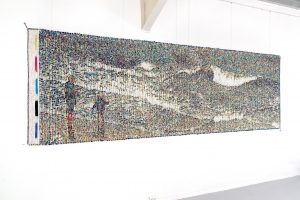
Lise Frølund Infinity 2015, jacquard weaving.
FrØland unquestionably capitalises on what weaving does so well – bringing together single threads to build an image that combines both surface and structure – while testing just how pixelated that image can be before the human eye grows confused.
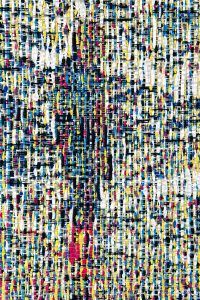
Lise Frølund Infinity (detail) 2015, jacquard weaving.
Downstairs British artist Claire Barber made used ferry tickets into temporary, portable looms woven in small patches with threads from her own clothing. Displayed as a grid of units pinned to the wall, You Are the Journey (2016) makes use of the repetitive and often unremarkable patterns of daily life to remind us that creativity requires resourcefulness and determination, but little else.
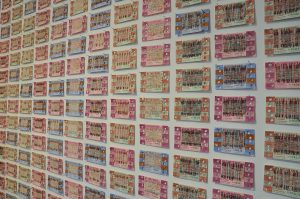
Claire Barber You Are the Journey 2016, ferry tickets, needle weaving.
A short walk across town, the outcomes of three invited artistic residencies were on display in the upper gallery of Casa da Memória. Initiatives that bring textile galleries and the textile industry together are unusual and deserve to be commended. Here Elena Brebenel’s collaboration with the MoreTextile group presented seven aesthetically accomplished lengths of printed translucent imagery based on plants native to Portugal, only let down by what was described as an “immersive” and “interactive” installation printed only on one side of the cloth.
A short walk away the elegant Museu Alberto Sampaio exhibited A Textile Memory: The Lausanne Biennials in partnership with the Swiss Foundation Toms Pauli based in Lausanne. Sheila Hicks Letter to Malevitch (1975) in white cotton with differing widths of weft; Olga de Amaral’s exquisite gradation of colour in Paisaje de Calicanto (1981); or Magdelena Abakanowicz Abakan Etroit (1967-68) of deep purple sisal all benefit from viewing in person.
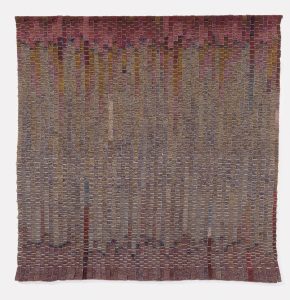
Olga de Amaral Paisaje de Calicanto 1981, linen, horsehair, wool, cotton, 300 x 290 cm. Fondation Toms Pauli, Lausanne. Photo: Fibbli-Aeppli, Grandson.
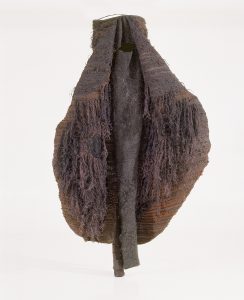
Magdalena Abakanowicz Abakan Etroit 1967-1968, Sisal, 320 x 100 x 100 cm. Fondation Toms Pauli, Lausanne. Photo:photo Fibbli-Aeppli, Grandson.
In contrast to these older works, much of the contemporary work included in Contextile felt as though it worked against the natural material inclinations – often deploying monofilament supports that we are never meant to see, but always can.
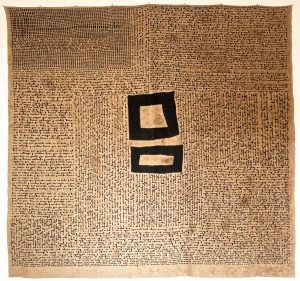
Amparo de la Sota Spain Letter 2016, linen, cotton, ink embroidery, I58 x 150 cm.
I am acutely conscious that I am praising the established over the emerging. But revisiting works by the likes of Hicks, de Amaral or Abakanowicz provides a humble reminder that these works are simply astounding. Each poses a confidence that works with, rather than against, the nature of textile materials. Compared to so many of our contemporary efforts it still feels as though we have much to learn.
– Jessica Hemmings
Jessica Hemmings, PhD, is Head of the School of Visual Culture and Professor at the National College of Art & Design, Dublin, Ireland.





Related Blog Articles
No related blog articles yet.